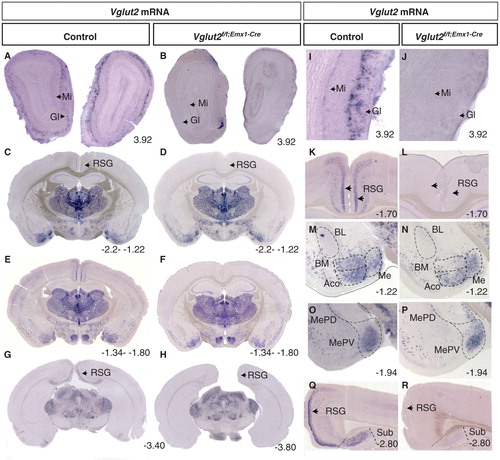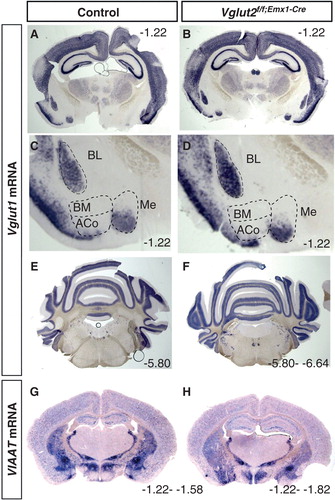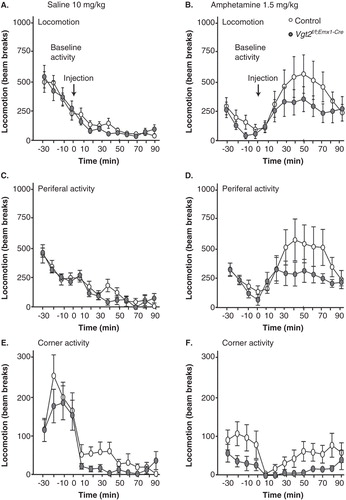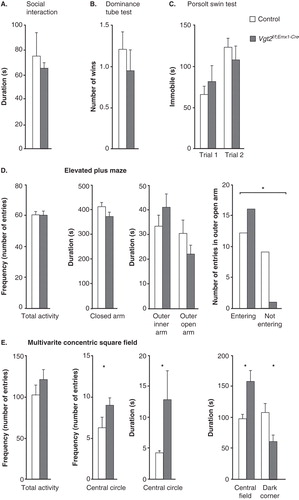Figures & data
Figure 1. Specific deletion of Vglut2 in selected forebrain target areas. Floating in situ hybridization on coronal brain (70 μm) sections from control mice and Vglut2f/f;Emx1-Cre cKO mice (A–H) using a DIG-labelled Vglut2 probe. Close-ups as indicated in I–R, which demonstrate that cells expressing Vglut2 mRNA was absent in the mitral cell (Mi) layer and GI layer in the olfactory bulb (I–J). Vglut2 mRNA was also absent in the RSG of the medial cortex in the Vglut2f/f;Emx1-Cre mice (K, L). There is a loss of Vglut2 mRNA in the BMA, in the ACo the mRNA is partially deleted, and the Me amygdala and MePV are unaltered in the Vglut2f/f;Emx1-Cre mice (M–P). Vglut2 mRNA positive cells were present in the Sub in control mice but not in Vglut2f/f;Emx1-Cre cKO mice (Q, R). ACo = anterior cortical amygdaloid area; BL = basolateral amygdaloid nucleus; BM = basomedial amygdaloid nucleus anterior part; cKO = conditional knock-out; DIG = digoxigenin; GI = periglomerular layer; Me = medial amygdaloid nucleus; MePV = posteriorventral medial amygdaloid nucleus; Mi = mitral cell layer; RSG = retrosplenial group; Sub = subiculum; Bregma interval (dorsal, ventral) is shown in lower right corner.

Table I. Summarized results from in situ hybridization evaluating the presence or not of Vglut2 mRNA in brain structures from three adult Vglut2f/f;Emx1-Cre cKO mice and three control mice.
Figure 2. Verification that the overall gross anatomy is normal in the Vglut2f/f;Emx1-Cre mice compared to control mice. Floating in situ hybridization on coronal brain (70 μm) sections from control and Vglut2f/f;Emx1-Cre cKO mice using a DIG-labelled Viaat (A, B) or Vglut1(C–H) probe. Close-ups show that ACo and BM do not express Vglut1 mRNA, while BL and part of Me express Vglut1 mRNA. ACo = anterior cortical amygdaloid area; BL = basolateral amygdaloid nucleus; BM = basomedial amygdaloid nucleus anterior part; Me = medial amygdaloid nucleus. Bregma interval (dorsal, ventral) is shown in lower right corner.

Figure 3. The Vglut2f/f;Emx1-Cre mice do not show any altered response to amphetamine. The initial response to novel environment (30 min) and overall response after i.p. injection of saline (90 min), 10 mg/kg, in locomotion, periferal activity, and corner activity are unaltered in the Vglut2f/f;Emx1-Cre cKO mice compared to control mice (B, D, F). On day 2, the mice were subjected to the activity boxes for 30 min and were thereafter administered 1.5 mg/kg amphetamine i.p. and were recorded for 90 min (A, C, E). The arrows in the graphs depict the time of saline and amphetamine injection. Data were analysed with two-way ANOVA and showed no significant interactions (effect of genotype). Data are represented as mean ± SEM. cKO = conditional knock-out.

Table II. Levels of monoamines and dopamine metabolites (ng/g of wet tissue) of Vglut2f/f;Emx1-Cre cKO (n = 12) and control (n = 18) mice. The data show no statistically significant alterations between control and cKO mice. Data are presented as mean ± SEM.
Figure 4. No social deficits or altered despair-like behaviour, but decreased avoidance of open areas and time spent sheltered. Social behaviour analysis on adult Vglut2f/f;Emx1-Cre cKO mice and control littermates (A, B). The total time spent interacting during a 10-min social interaction session shows no alteration in the Vglut2f/f;Emx1-Cre cKO mice compared to control mice (A). The number of wins in the social dominance tube test shows that the Vglut2f/f;Emx1-Cre cKO mice do not display any altered dominance compared to control (B). The Vglut2f/f;Emx1-Cre mice spent equal time swimming during two 12 min swimming sessions separated 24 h apart in the Porsolt swim test (C). The total activity and the duration in the three different areas in the elevated plus maze show no significant differences between genotypes. The number of total entries in the outer open arm is statistically different between the Vglut2f/f;Emx1-Cre cKO mice compared to control mice (*P < 0.05, chi-square test) (D). The total activity as measured in the multivariate concentric square field (MCSF) shows no altered behaviour for the Vglut2f/f;Emx1-Cre cKO mice compared to control mice. The frequency in the central circle and duration in the central circle as well as in central field are significantly increased for the Vglut2f/f;Emx1-Cre mice compared to control mice; the duration in the dark corner is significantly decreased in the Vglut2f/f;Emx1-Cre cKO mice compared to control mice (E). Values represent mean ± SEM. * P < 0.05 compared to control littermates. cKO = conditional knock-out.

